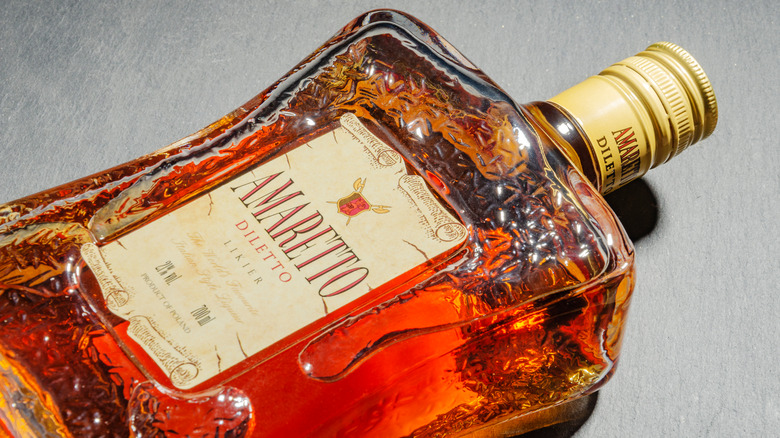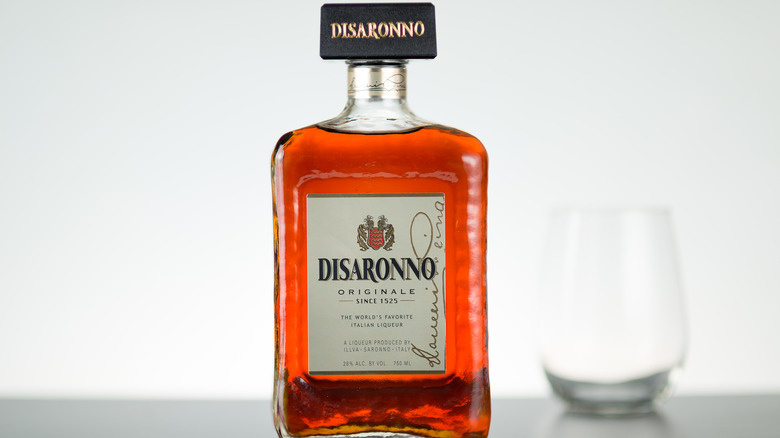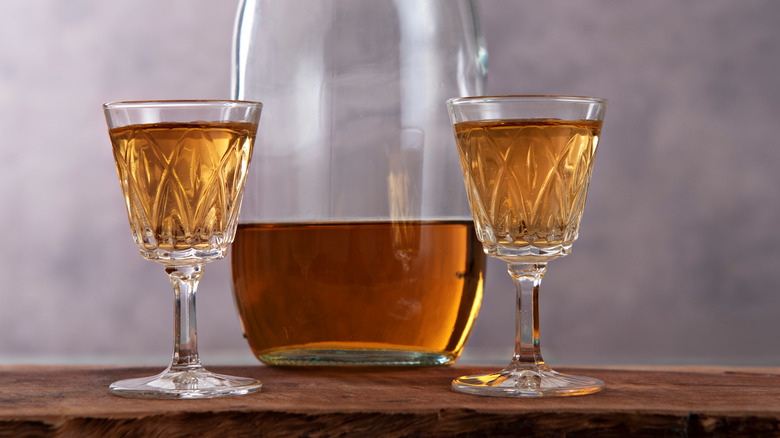What Is Amaretto And What Does It Taste Like?
Going out for cocktails with friends is fun, but on nights when you'd like to enjoy an adult beverage without the $15 price tag, having a well-stocked home bar is key. Alcohol-enthusiast Ina Garten likes to keep hers equipped with Scotch, vodka, bourbon, and gin, along with a few key mix-ins like club soda and ginger ale (via Barefoot Contessa), but that's just a shortlist of spirits that you should try to keep on hand. Along with the other "main" liquors like rum and tequila, you also want to make sure you have a few liqueurs available so you can mix up a fun drink or two during your night in.
Of course, the term "liqueur" opens up a whole separate world of boozy beverages to decide between, but if you're only looking to have one bottle of the sweet stuff on hand, we highly suggest going with an amaretto. The cordial of Italian origins can be enjoyed on its own or mixed with another libation for a delicious drink that's easy to swallow, and also has the added bonus of being a tasty addition to baked goods. If you're still not sold on amaretto, here's a little more information about the liqueur to help convince you to always keep a bottle on hand.
What is amaretto?
Amaretto is a type of liqueur, which is essentially a liquor pumped full of additives to give it a sweet taste and flavor. Though a bit of a newbie to the bar scene in the United States, where The Spruce Eats says it did not start appearing on shelves until the 1960s, it is actually an old favorite in its home country of Italy, though its origin story differs a bit depending on who you ask.
According to The Spruce Eats, the first tale of the beverage credits its creation and ownership to the Lazaronni family of Saronno. The family was known for its amaretto cookies, and eventually developed the liqueur based on their recipe for the baked goods in 1851. Delicious Magazine, however, details another story of amaretto that dates all the way back to 1525. This "legend" goes that the cordial was created by a widow who not only posed for the painter Bernardino Luini but eventually became his lover. The woman made up a potion of sorts from apricot seeds soaked in brandy to express her love for the Renaissance artist, a recipe that was then passed down through generations. It eventually made its way into the hands of the Reina family, who used it to make one of today's most popular brands of amaretto, Disaronno Originale.
What does amaretto taste like?
The Italian translation for amaretto — "little bitter" — happens to describe the taste of the libation pretty well. As with most liqueurs, the variety of booze that Thrillist says has an alcohol-by-volume of anywhere between 21-28% masks its alcohol taste with a delectable sweetness, but that's not all. The cordial also has a distinct almond flavor that makes up the slight bitterness described in its Italian meaning. Almonds aren't usually at the source of the beverage, however; that falls to apricot pits, or sometimes a combination of both (via The Spruce Eats). Some brands will add a mixture of herbs and spices to their amaretto that can be detected as well.
Drinking an amaretto straight is certainly an option, though Thrillist warns that it may be a little too sweet, or even have a similarity to cough syrup. The website suggests combating this by mixing the liqueur with another spirit, like bourbon, or at least pouring it over ice. It also may be better to spend a little more and go for a premium amaretto when choosing one for your home bar, as The Spruce Eats notes that they tend to be less sugary than the cheaper versions.
Amaretto vs. amaro
We've already told you that amaretto translates to "little bitter" in Italian, but we didn't tell you why. As explained by The Spruce Eats, amaretto actually derives from the word amaro, which translates to "bitter," while the suffix -etto adds the "little" to its meaning.
Here's where things get slightly confusing. As it turns out, amaro is also a type of liqueur — but don't expect the same sweet and nutty flavor profile that you'll get from sipping Disaronno on the rocks. According to Italy Magazine, amari (the plural form of amaro) are made of a combination of alcohol and spices, herbs, or fruit, though the exact blend differs throughout Italy, as each region incorporates its own local ingredients into the drink. Unlike the much sweeter amaretto, an amaro generally has a more bitter taste that lends itself to cocktails like an Aperol spritz or a negroni, and may have a higher alcohol content — up to 40% — as well (via A Bar Above). Amari are also sometimes served straight after dinner, as Made In Italy notes that they are said to help aid in digestion.
How to use amaretto for cocktails and more
As with nearly any alcoholic beverage, amaretto can simply be poured in a shot glass and thrown back, but the liqueur can also be used for some even tastier creations. If you're looking for something on the easier side, Delicious Magazine suggests mixing the libation with cola for a concoction that the publication likened to a boozy Dr. Pepper. Of course, you can also add a little bit to a cup of black coffee, or even pour some over ice cream to give your dessert an extra kick.
Those looking to channel their inner mixologist may enjoy a suggestion backed by Jon Taffer himself. The "Bar Rescue" host's drink of choice is a Godfather, which is a simple cocktail made up of two ounces of Scotch and ½ ounce of amaretto (and yes, this drink does get its name from the movie franchise). Other popular drinks include Alabama slammers and, of course, an amaretto sour (via Town & Country).
Amaretto can also go beyond your home bar, as The Spruce Eats notes that the liqueur can be used in a number of desserts like tiramisu, or even incorporated into savory dishes such as fish and poultry.
Here's how to make your own amaretto at home
Sure, you can pick up a bottle of amaretto from your local liquor store, but where's the fun in that? The liqueur is actually surprisingly easy to make, allowing you to customize the taste and flavor to your liking. Homemade amaretto would make a great birthday or holiday gift as well.
The basic recipe for a homemade amaretto requires a handful of ingredients, many of which you likely already have around your house. Per The Spruce Eats, all you'll need is water, granulated white sugar, brown sugar, vodka, vanilla extract, and almond extract. Start by bringing your water to a boil, then add in both your sugars. Reduce heat and simmer until the sugar has dissolved, leaving you with a syrupy liquid that you'll then want to remove from the stove and let completely cool. Next, add in the vodka and both extracts and stir the mixture up well before transferring into a glass bottle to either store in your homemade bar or give to a friend. Enjoy!





